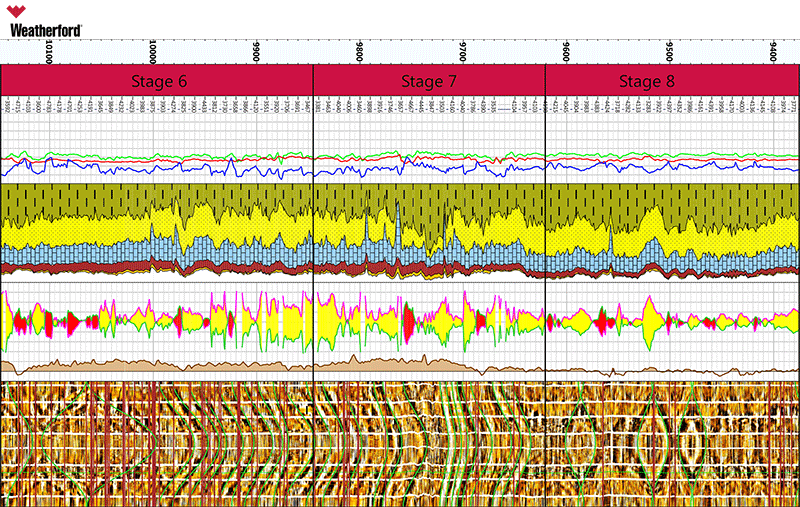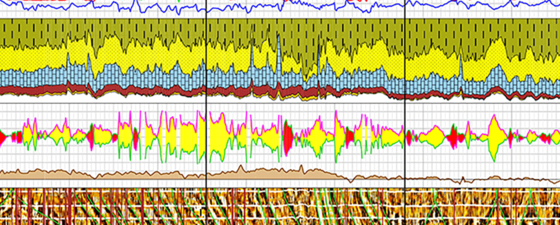Two key focus areas in unconventional exploitation are cost efficiencies and managing well production variance. A better understanding of rock behaviour as measured by anisotropic brittleness analysis can help select the best fracture placement in horizontal shale wells, while proper reserve estimations and hydrocarbon production potential can be analysed using advanced TOC percentage calculations.
Eagle Ford Case Study
Recently, an Eagle Ford shale operator wanted to optimise fracture efficiency and well productivity in a field development campaign. To properly account for the geological complexities of the lamination depositional mechanisms associated with shale formations, the operator deployed advanced logging while-drilling (LWD) technologies to measure the variability along the lateral section of one of its wells. The introduction of the transverse isotropy anisotropy evaluation from the LWD azimuthal acoustic measurements allowed an accurate characterisation of the impact of the extensive laminations across the planned well trajectory. Concurrently, the petrophysical evaluation used isotope concentrations from a LWD spectral gamma ray tool, providing an integrated analysis that accounted for both the reservoir and rock property variability along the lateral section of the well.
 WeatherfordAfter acquiring the data, the operator sought guidance on how to optimise cluster perforation and stage placement, turning to Weatherford’s FracAdvisor™ for the answer. By grouping ‘like rock with like rock’ through an advanced interpretation of the available formation evaluation logging data, the service produced a completion design that minimised uncertainties in proppant amount and pumping times and provided pressure profiles optimisation.
WeatherfordAfter acquiring the data, the operator sought guidance on how to optimise cluster perforation and stage placement, turning to Weatherford’s FracAdvisor™ for the answer. By grouping ‘like rock with like rock’ through an advanced interpretation of the available formation evaluation logging data, the service produced a completion design that minimised uncertainties in proppant amount and pumping times and provided pressure profiles optimisation.
By combining several key and unique formationevaluation technologies with innovative surface logging tools and advanced laboratory techniques, FracAdvisor provided near real-time guidance for enhanced completion decision making. Using advanced and flexible modelling, the service assessed natural fractures, evaluated hydrocarbon potential, and calculated mechanical properties along horizontal or vertical wellbores. By evaluating attributes such as TOC, maturity, porosity, permeability, natural fracture patterns and mechanical properties, the operator had a reliable prediction of fracture potential.
Key Insights Provided
FracAdvisor seeks to optimise the contribution from each stage, enabling operators to complete a well in a structurally complex geologic environment, identify and stimulate sweet spots, and optimise stage design and cluster placement, mitigating the fracturing-potential variability caused by formation heterogeneity properties. High-resolution imagers and advanced acoustic technologies evaluate structural patterns in the wellbore – including fracture and fault identification – to provide a better understanding of rock mechanical behaviour and deliver a more realistic approach under laminated structure of the shale diagenesis. A spectral gamma ray tool measures elemental radioactive concentrations during petrophysical interpretation of hydrocarbon potential, that enables the completed reservoir characterisation to be incorporated into a robust weighting model allowing the operator to select the best fracture placement and design in an unconventional environment. Furthermore, the FracAdvisor service leverages an advanced coring data technique to reduce uncertainty during evaluation, as well as wellsite geochemistry data from new-generation gas-detection technologies.
These attributes are used to calculate completion and reservoir indexes; the former indicates how the rock will behave under hydraulic fracturing, while the latter indicates whether the particular rock will contribute to production. Each attribute is weighted by factors such as basin experience, hydraulic fracturing technique, and data uncertainty. The reservoir and completion indexes are incorporated in a combined FracAdvisor index, providing input for a fully automated stage-design proprietary workflow which optimises the length of each stage and location of perforations by seeking to minimise the variability in the attributes. This enables analysts to calculate how the rock will behave under hydraulic fracturing and how it will ultimately produce. For the Eagle Ford operator, this service provided key insights into the design of the completion programme for future wells. The ability to accurately identify sweet spots provided direct input for well planning and geosteering operations and offered a proactive design for future wells and maximum production potential.





